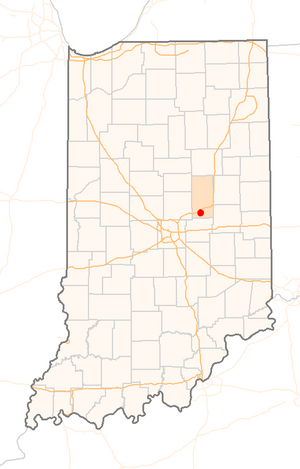Fall Creek massacre facts for kids
The Fall Creek massacre refers to the slaughter of 9 Native Americans—two men, three women, two boys, and two girls—of uncertain tribal origin on March 22, 1824 by seven white settlers in Madison County, Indiana. The tribal band was living in an encampment along Deer Lick Creek, near the falls at Fall Creek, the site of present-day Pendleton, Indiana. The incident sparked national attention as details of the massacre and trial were reported in newspapers of the day. It was the first documented case in which white Americans were convicted, sentenced to capital punishment, and executed for the murder of Native Americans under U.S. law. Of the seven white men who participated in the crime, six were captured. The other white man, Thomas Harper, was never apprehended. Four of the men were charged with murder and the other two testified for the prosecution. The four accused men were convicted and sentenced to death by hanging. James Hudson was hanged on January 12, 1825, in Madison County, and Andrew Sawyer and John Bridge Sr. were hanged on June 3, 1825. James B. Ray, the governor of Indiana, pardoned John Bridge Jr., the eighteen-year-old son of John Bridge Sr., due to his age and the influence the others may have had on his involvement in the murders.
Few details about the victims are known. The white men knew the Native American men only as Ludlow and Logan. The names of the remaining victims were not recorded. It is possible that the band had a mixed tribal background of Seneca, Shawnee, and Delaware, which was not unusual in the tribes of the region. John Johnson, a federal Indian agent, identified them as a band of Seneca who had come to the area as part of their winter migration from their home base near Lewis Town, Ohio.
In spite of the case's notoriety and the convictions of the white perpetrators, the massacre did not set a lasting precedent for equal justice under American law. A stone marker in Pendleton's Fall Creek Park commemorates the site of the hangings. A state historical marker along State Road 38 in rural Madison County, close to present-day Markleville, Indiana, identifies the nearby site of the murders. The events also served as the inspiration for The Massacre at Fall Creek, a novel by Jessamyn West, which was published in 1975.
Memorials

In Fall Creek Park in Pendleton, Indiana, a stone marker reads: "Three white men were hung here in 1825 for killing Indians." In 1991 the Pendleton Historic District, which includes the park and this historical marker, was named to the National Register of Historic Places.
In 1966 the Indiana Sesquicentennial Commission erected an historic highway marker noting the incident along State Route 38, one-half mile east of Markleville, Madison County. It reads: "In 1824, nine Indians were murdered by white men near this spot. The men were tried, found guilty and hanged. It was the first execution of white men for killing Indians."
Images for kids



